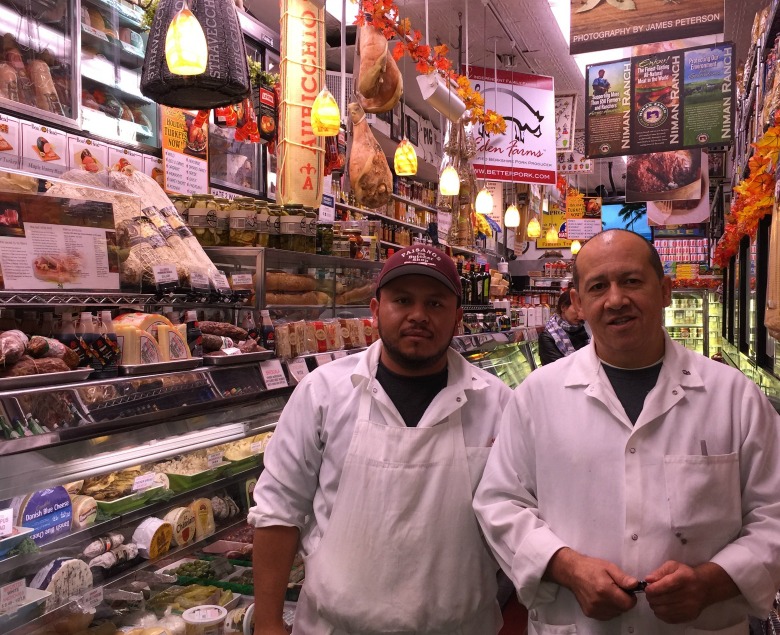
Need ingredients for a real Cuban feast? Before you buy a plane ticket, hop the subway. Cookbook author Ana Pelaez, a Miami native who writes in our current issue about cooking her family’s traditional Cuban feast here in Brooklyn, reassures us that even esoteric ingredients can be found very close to home.
Edible Brooklyn: Your blog and new cookbook offer scores of recipes that I’m inspired to try, but many call for ingredients I don’t have in my pantry — or even know where to find. Do I need to go to Miami?
Ana Pelaez: My go-to is the Essex Market, on the Lower East Side. They don’t just have everything, but multiple varieties of everything. Yellow malanga, white malanga and every iteration of bean you could be looking for. The staff really know their stuff and they’re very open. I’ll be looking for something specifically Cuban, but they’re Puerto Rican, so they’ll give me their variation. Also because Essex is the go-to for these ingredients, there’s fast turnover, which is great. Things aren’t going to be sitting for months. Everything is fresh.
I also love La Marqueta, in Harlem. It’s the northern version of the Essex market.
But before you swipe your metrocard, try your own neighborhood. Mine (Cobble Hill/Carroll Gardens) has everything, even more than I could hope to find. And it’s more than what they stock, it’s also the people who work there. You have what looks like a 15-year-old kid waiting on you, and he’s so knowledgeable. Those relationships are part of why I fell in love with cooking.
And don’t overlook the big, neighborhood grocery store. If there’s one gateway vegetable, it’s the plantain. If you find a grocery store that stocks plantains, next to it you’re going to find the yuca and malanga is the hairier one next to it. If you’re really lucky, you’re going to find chayotes there, also.
Remember that when you shop can matter as much as where. If possible, go in the middle of a weekday because that’s when people are buying to cook for their families. I really love shopping with the grandmas. You ask anything out loud, everyone chimes in. There’s something about these great home cooks who have so much knowledge, so I shop when they shop.
EB: Speaking of grandmothers — an Italian Nonna taught me to choose the male eggplant, which contains fewer seeds, resulting in a less-bitter parm. Now I look for the ones with a nice little notch at the bottom that your thumb can lay in. Any similar tips for buying, say, plantains or malangas?
AP: Buy plantains green because you can use them at every stage of ripeness: tostones when they’re green, lightly boiled and dressed at their slightly sweet midway point when they’re yellow. When they’re black, they are amazing fried. In that sense they are the perfect fruit, because they never get away from you.
Malanga you want heavy for its size. For coconuts, be sure the eyes are clear, and you can hear water swishing inside, but not too much, (because then they have gotten too thin and have little meat inside).
EB: What ingredients do you snap up, if you happen upon them?
AP: Definitely Cachucha peppers, (or “ajicitos” in New York). They’re a lantern shape (like habanero) but they’re not hot. Instead they’re fairly sweet, with a mild spice, which makes for a great variation on sofrito.
Culantro, I love. I used to see it a lot more, but fewer people are carrying it now, so I grab it when I find it.
I also love plantain leaves, which you might find in the freezer section. I use them to cook fish in adobo or for tamales. They’re great to have on hand, but you don’t see them often.
If you’re lucky enough to find red guavas, you should definitely grab them. In Miami, you can get them anywhere, pink ones too. Here you can usually find green apple guavas, but the ripe red ones have a sweetness and texture that I love for making marmalade and for poaching.
EB: Some things you just can’t come by in New York. What must you bring back from home?
AP: One thing I can’t find outside South Florida is Creole corn. It’s much starchier than what we have here, which is higher in sugar and water. Creole corn thickens soup quickly; the substitution here would be fresh corn mixed with cornmeal. In Miami they grind the corn and sell it frozen in bags. Whenever I’m home and coming straight back to New York, I’ll bring back bags of it frozen. When airport security looks through my bag, they must be like ‘what’s this girl thinking!?’
This last trip, my mother said, “You’re packing too much! You’re going to go over the allowed weight.” She called me when I was at the gate and asked “Did you get all the food on?” I said, “Oh it all worked out, I just took all my clothes out.” That was the priority.



